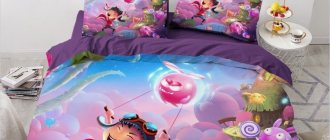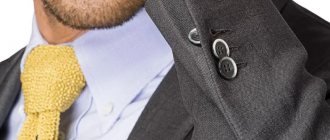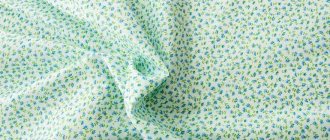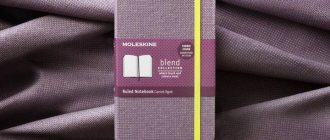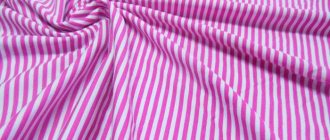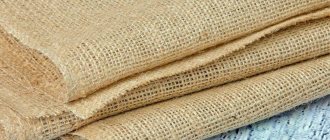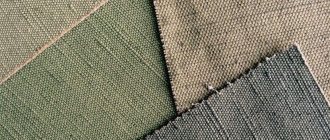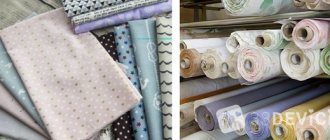27.09.2019
Hi all. I very often heard questions of the following kind: is this calico made of natural cotton or is this cotton fabric natural? Of course, these questions do not arise out of nowhere, especially in our difficult times, where on every corner they offer a fake at the price of a natural product. After such questions, I felt the desire to write an article, thanks to which attackers will have much less chance of deceiving you.
1. 2. 3. 4.
A little about cotton and cotton fabrics.
Cotton is an environmentally friendly product.
Cotton, and, as a result, natural cotton fabric themselves are a natural and environmentally friendly product. Such famous types of fabrics as calico are made from cotton, and at the same time, they may differ in price. It's all about the varying complexity of production. The cost can vary from 1000 rubles to 10,000 thousand or more. Agree, I would not want to buy satin for 5-6 thousand rubles, which is made from synthetics and is not worth even a fifth of this money. That is why we read on and gain useful knowledge. By the way, I would like to point out that cotton and cotton fabric are the same thing.
Let's summarize.
This is where I will end my article. Be more careful when choosing bedding or cotton fabrics. Use all the voiced methods, choose the best. If you have a lot of experience in identifying natural cotton fabrics, I and all readers would love to hear from you. Leave your tips in the comments. Don't forget to repost. Sincerely, Victoria Morozova.
How to distinguish natural fabric from synthetics? This problem especially often arises when purchasing bed linen. People out of habit believe that if it is calico, it must be pure cotton. But, whether it is calico or poplin, this definition does not refer to the quality of the thread from which the fabric is woven, it is the name of the weaving technology. And, as you understand, you can weave it from any thread, even from wire. Therefore, in order not to feel deceived, you need to know how to check what fiber the product is made of.
The first test is tactile sensation.
Even if the fabric is natural, you don't have to like it. And this factor plays an important role when choosing. For example, for many, pure flax fiber seems coarse; they also often talk about thick and high-quality calico.
Satin seems thin to many, although it is completely opaque, like calico, comfortable, and a pleasure to sleep on. Therefore, relying only on tactile sensations, you can just buy soft, pleasant, velvety, but synthetic underwear.
There is a simple home way to check the naturalness of the thread - you need to set it on fire.
If you buy clothes, then, as a rule, there is a spare piece of fabric, you can conduct an experiment on it.
With bed linen it is more difficult; a fabric sample is not included with it, so you will have to be smart about how to check whether the fabric is actually natural, as stated by the manufacturer.
So, if you have a piece of fabric or at least a thread, let's start doing research. To do this, we need a safe place, matches, and the ability to ventilate the room.
Cotton or viscose
It is not easy to distinguish these materials, but we know how to determine whether the fabric you are looking at is artificial or not. Viscose is made from natural raw materials - natural cellulose. The technological process is called xanthogenation, which produces fibers for the production of threads. During the reaction, the crystal lattice of the substance changes, which is why viscose is considered synthetic. It has the properties of natural fabric, which is why it is widely used for sewing summer wardrobe items.
Cotton mother is not characterized by shine, but this is a characteristic feature of artificial materials. If we compare viscose and cambric, which has this property, it can be noted that viscose is denser. The shine of cotton fabric is given by the natural silk fibers that are included in the composition. Therefore, you can notice the differences by looking closely.
It is permissible to study the composition of the fabric experimentally. If you have a cut at home and want to find out whether it is rayon or cotton, you need to pull out a few threads at the cut point and set them on fire. The nature of the flame in both cases will be the same. Even combustion products are not much different. To determine what fibers a fabric is made of, you need to pay attention to the smell. When cotton burns, it is similar to paper. But viscose will leave behind a stench, which is characteristic of smoldering cotton wool.
Composition of each fabric
No one will argue that cotton is made from natural raw materials - cotton seed fibers. If synthetic or artificial substances are not mixed into the raw materials during their processing and production of cotton fabrics, we can talk about 100% natural cotton. Fabrics for a wide variety of purposes are made from it:
- for everyday wear at home or “going out”;
- dress and costume groups,
- children's clothing,
- home textiles, etc.
Mostly such fabrics are intended for use in the warm season.
Viscose also has a natural composition - it is recycled cellulose. Depending on the type of weave, the thickness of the fibers, the method of their processing, as well as the final finishing, it can be similar to natural fabrics such as silk, wool, linen or the same cotton. Therefore, it is sometimes confused with them. But at the same time, viscose is a cheaper material than its natural counterparts.
In addition to the production of clothing fabrics, viscose is very widely used for the production of household textiles, materials for household needs, as well as carpets and artificial fur. It is often added to natural or synthetic fabrics to improve their characteristics. Then we are talking about mixed fabrics.
How to distinguish natural fabric from synthetic
- Cotton fiber burns with a light flame, burns very quickly and does not leave a strong odor, to some it slightly resembles the smell of burnt paper. There is very little ash left, and it is completely weightless.
- Flax also burns quickly, leaving very little bright gray ash, but leaves no odor.
- Pure wool thread burns very slowly and reluctantly, eventually shrinking into a ball, filling the space with an unpleasant odor reminiscent of burnt hair or feathers.
- Artificial wool burns very quickly and beautifully - the flame is blue, and the smell will be as if paper was set on fire.
- Viscose obtained artificially from wood, i.e. cellulose is considered a natural fabric. Viscose burns very quickly, but smolders for a long time, actively smoking and emitting the smell of burnt cotton wool. The remaining gray ash crumbles well.
How to distinguish natural silk from artificial silk
Natural silk does not want to burn at all, no matter how hard you try. The thread will shrink into a black knot, and the flame will immediately go out. The smell is vaguely reminiscent of burnt keratinizations (nails, claws, horns), if you have ever heard such a smell.
It is very easy to distinguish artificial silk from natural silk. It burns well and quickly, without crackling or odor.
When buying a silk item, you will not start a fire in the store, so just squeeze the fabric in your hand, unclench your fist after a while and see if the fabric is wrinkled. Artificial silk will have noticeable creases, while natural silk will wrinkle quite a bit.
A characteristic feature of all burnt natural samples is the ability to easily crumble combustion residues. Artificial thread does not provide such an opportunity, in addition, when artificial material burns, it emits an odor mixed with sourness.
Acetate silk can melt in acetone, which cannot be said about natural silk.
Recently, a lot of mixed fabrics have appeared that contain natural thread in combination with artificial thread. The manufacturer is required to indicate the percentage of all types of threads - these can be acrylic, acetate fiber, lavsan and other artificial additives. If you set fire to such fabric, the flame will be similar to the thread that contains the most of it. The smell will also determine the composition, but the remains of combustion cannot be easily crushed.
Mixed fabrics used in the production of bed linen are, as a rule, very pleasant to the touch, have a durable color, practically do not wrinkle and last a long time if used correctly.
Be able to distinguish natural fabric from artificial fabric
It is also necessary to properly care for the product.
In the old days, there were only natural fabrics everywhere: they simply didn’t know how to make others. Then the world was rocked by discoveries such as the creation of polyester and other synthetic fibers. Then the scales tipped in the other direction again, and a whole trend for everything natural emerged. But while everyone around is talking about the dangers of “all chemicals,” let’s study the materiel a little. Should you give preference only to natural products?
How does cotton differ from other materials?
The textile industry market is replete with a variety of materials. You can determine which material is better by studying the properties of each and comparing them with the characteristics of cotton fabrics.
How to distinguish cotton from synthetics
There are different types of synthetics, however, the properties of each type of synthetic materials are relatively the same. Synthetics, unlike cotton, do not wrinkle, do not allow moisture to pass through easily, and generate static electricity. If you can't figure out whether it's cotton or synthetic, look at the labeling. The presence of spandex, elastane or substances with the prefix “poly” indicates that it is synthetic. In addition, cotton materials can withstand high temperatures well, while synthetics can easily stick to the sole of the iron. If you burn a small piece of fabric, the synthetics will simply melt, and the cotton will burn and produce smoke with the smell of burnt paper.
The difference between the material and satin
Sateen is cotton, but only made by a special method of weaving the best and longest cotton fibers. Unlike natural cotton, satin has a characteristic shine on the surface. There are often cases when synthetic fibers are added to satin to increase the wear resistance and service life of the material.
The difference between cotton and calico
Calico is a type of cotton produced by plain weaving. The result is a fairly dense canvas with a matte surface. Calico is considered a lower quality material than cotton, withstands fewer washes, shrinks more often and quickly loses its color saturation.
How to understand where is cotton and where is linen
Unlike cotton, linen is stiffer, stronger and attracts less dust. Linen items are warmer than cotton items. In appearance, linen has a little more shine than cotton. The material also wrinkles more and is difficult to smooth out. To learn how to determine in the future whether you are looking at cotton or linen, visit a fabric store and study both materials based on their external properties.
How is cotton different from poplin?
Both materials are made from natural cotton fibers, but differ greatly in appearance due to special processing and weaving of the threads. Poplin, unlike classic cotton, is more durable and reliable, but costs more.
The difference between fabric and viscose
Viscose is an artificial material made from wood cellulose. The fabric can consist of either 100% pure raw materials or contain additional artificial or natural fibers. In its pure form, viscose is used extremely rarely, as it suffers greatly from water and is not very durable. Most often, elastane, polyester or pure cotton fibers are added to the material. Viscose, unlike cotton, does not shrink, fades less in the sun, and holds its shape worse.
How to distinguish cotton from polycotton
Polycotton is a mixture of natural cotton fibers and polyester threads. Unlike cotton, polycotton is less pleasant to the body, less breathable and can cause skin reactions. However, products made from polycotton last longer, are more wear-resistant, practically do not wrinkle and are cheaper.
How to distinguish natural bedding from synthetics:
The first method is not very accurate, but it will allow you to avoid buying a low-quality fake already at the selection stage. Synthetic bed linen
weighs 1.5-2 times lighter than a similar one made from natural cotton or linen. Just compare the weight of the package, and if the linen is suspiciously light, refrain from purchasing it.
The second method is associated with the properties of synthetics to become highly electrified. If you rub synthetic fabric, it can crackle and glow in the dark - probably everyone has encountered such phenomena at some point in their lives. With natural fabric made from cotton, linen or bamboo
this will never happen.
The third method is testing for creaseability. Synthetic fabrics, as a rule, do not wrinkle at all and regain their shape very quickly. Natural bed linen fabric
will definitely doubt it, to a greater or lesser extent, since this is a property of all natural fabrics.
The fourth method is to determine synthetics by the sheen of the fabric. Synthetic fabrics
have a characteristic shine, which is why they often look more beautiful than natural ones. But you shouldn’t fall for this unnatural beauty. This method is not suitable for satin and silk, as these natural fabrics can also have a smooth, shiny surface.
The fifth method is very accurate, but it can only be applied after purchase. If you remove the thread from the fabric, from the wrong side, and set it on fire, then the natural fabric
burns, smells like burnt paper and leaves ash. Synthetics either smolder or melt, leaving no ash and a completely different smell.
The sixth method is to check for fabric pilling. If during use on bed linen
If “pellets” appear, then most likely the fabric is artificial. Think about your old cotton items - even if they are very worn, they will never have the “pillings” characteristic of synthetics.
The seventh method is the drying speed of bed linen. Synthetics dry very quickly, sometimes even after spinning in the washing machine it is almost dry. Ani will take much longer to dry.
We hope these methods will help you avoid a bad purchase. Although, of course, not all of them are applicable at the stage of choosing a bedding set.
- Quick view
Varieties of cotton
The textile industry produces dozens of different fabrics from cotton fibers, which are used for sewing clothes, making household items and interior design. Thus, long-staple cotton is used to obtain the highest quality fabric that is light, smooth and airy. Let's look at a few popular fabrics.
- Batiste. A thin, translucent fabric from which elegant items are sewn: shirts, tablecloths, napkins.
- Poplin. A type of fabric with a small transverse rib, from which bed linen, sleepwear, and men's shirts are made.
- Satin. Smooth, shiny fabric, used for sewing men's shirts, summer dresses, bed linen, and as a lining material.
- Volta. Silky, dense fabric, reminiscent of cambric. Light elegant dresses and underwear are sewn from it.
- Percale. Plain weave material, soft and silky. It is well suited for printing complex prints and washes well. The highest quality bed linen is made from percale.
- Taffeta. A smooth fabric with a pleasant shine, from which mainly elegant and wedding dresses are sewn.
Cotton with thin and long fibers is also used to produce other fabrics: guipure, muslin, tulle, krashe and others.
Medium-length cotton fibers produce fabrics that are widely used and affordable. They produce a wide range of textile products.
- Calico. High density, used mainly for sewing bed linen.
- Cretonne. Dense, rigid fabric is made from threads of different colors, which gives a geometric pattern when weaving. Creton is used for furniture upholstery and wall decoration.
- Tights. Fabric made from fine yarn in a twill or patterned weave. Mainly for sewing suits and trousers.
- Mitkali. These types of fabrics (Muslim, Madapolam and others) are used to produce napkins, tablecloths, and bed linen.
Medium-fiber cotton is also used to produce carded sateen, chintz and other types of fabrics.
Short-staple cotton is used to produce inexpensive fabrics: flannel, flannel, and cotton wool, which are used to make home and children's clothing. Artificial and non-woven fabrics are produced from very short fibers (less than 20 mm).
Created by nature
So, let's start with the fact that natural fabrics are divided into four groups: cotton, linen, wool and silk.
There are a lot of cotton fabrics. Among them there are both thin ones - summer T-shirts, shirts, light trousers and jumpers are made from them, as well as dense and fleecy ones (for example, denim, flannel, corduroy), which provide good warmth. Cotton is good for many things: hypoallergenic, pleasant to the touch, durable, easy to wash and iron. But there is another side to the coin: it stretches when worn, sheds quickly, does not remove moisture well, gets wet and takes a long time to dry, so it is not suitable for sports.
The main advantage of flax
the fact that it is not hot even in extreme heat. After all, it not only protects the body from overheating, but is also able to give you a little extra coolness. This is a thin but durable fabric with a pleasant texture. But linen wrinkles very much and is difficult to iron, remember?
Wool
indispensable in the cold season: it warms well and removes moisture, and is pleasant to wear. Therefore, classic suits made of fine wool, tweed jackets and cashmere scarves are always beyond competition. However, caring for fur is not so easy and it can cause allergies.
Silk items are superior to their counterparts in durability and beauty. Silk
It is very pleasant to the touch, dries quickly, and is comfortable in the heat. But this is a delicate fabric, so silk ties, plastrons, scarves, shirts and suits require special care.
In a nutshell, natural fabrics are of plant or animal origin, so they are environmentally friendly, breathe well and have excellent thermoregulation, but can be fragile and require careful handling.
Comparison of properties
So are some fibers better than others, and if so, why? Let's start with the fact that the composition of viscose and cotton is very similar. And by their texture, they are often indistinguishable from the outside.
At home, you can try to determine the fibrous composition by combustion, but even this is very difficult: both fibers burn similarly: quickly and brightly, with a glow, and after extinction they smolder for a long time, forming ash. The only difference is in the smell, and that is very subtle: viscose gives off the pungent smell of burnt cotton wool, cotton gives off the smell of burnt paper.
However, you cannot conduct such a test in a store, so when purchasing, it is important to look at the textile composition indicated on the item’s label, provided that you trust the clothing manufacturer. Here the main question will be: what fabric to choose when purchasing based on its properties? The thing is that the properties of these fabrics are also largely similar, and the differences cannot be determined in the store. Cotton properties:
The thing is that the properties of these fabrics are also largely similar, and the differences cannot be determined in the store.
Cotton properties:
hypoallergenic due to the natural composition; high hygroscopicity - the ability to absorb moisture and sweat; breathability - in cotton clothes the body breathes; lends itself well to shaping when ironed, holds its shape for a long time, and is slightly deformed; ease of processing - does not fray much, does not slip, does not warp, which is important for home sewing; pleasant to the touch; withstands fairly high washing and ironing temperatures; quite high strength; not electrified; wrinkles a lot; fades in the sun and may fade when washed;
tends to shrink.
Properties of viscose:
- hypoallergenic;
- high hygroscopicity;
- breathability;
- the fabric is pleasant to the touch;
- has a variety of produced textures;
- drapes well;
- not electrified;
- does not fade or fade;
- is characterized by low cost;
- capricious in care, requires special delicacy;
- does not hold its shape well;
- wrinkles a lot;
- loses strength when wet and under active exposure to ultraviolet radiation.
From this comparison, only a small difference is visible. The superiority of cotton is its dimensional stability and higher strength. And the advantages of viscose lie only in aesthetic and price properties. Unless, of course, we are talking about such a modern viscose fabric as modal. Its composition is the same as cellulose. But thanks to the peculiarities of production, modal is significantly superior to cotton even in such indicators as hygroscopicity and strength. Therefore, when the question arises about which fabric to prefer for everyday wear in the hot season (or, for example, with hyperhidrosis - increased sweating), the answer may be in favor of modal viscose fabric. The same goes for choosing fabric for bed linen.
Man made
There is an opinion that synthetics may not be very beneficial for health. There is some truth in this, but not everything is so scary. Modern technologies make it possible to produce fabrics that are not inferior to natural ones in many respects, and even superior to them in others. Durable, practical materials are created from artificial fibers, which are used mainly for the production of sportswear and clothing for active recreation. These are very soft and warm fleece, practical Polartek, breathable membrane fabrics, durable nylon, etc. What fibers are they made from?
Acrylic
conventionally called artificial wool. He looks like her too: soft and warm. Inexpensive sweaters, jumpers, scarves and hats made of acrylic are noticeably lighter than wool ones. But its ability to pass air is much lower and it quickly loses its original appearance.
Polyamides
They are quite durable, they retain their shape for a long time, do not stretch or shrink. Fabrics made from such fibers are easy to clean and dry, but they do not provide heat, do not remove moisture from the body, and become electrified. They are used to make waterproof windbreakers, some sportswear, bags, and backpacks.
GORE-TEX ® membrane under a microscope
Polyester
- the fiber is ambiguous. You should not buy everyday clothes made from it: they are not very comfortable and can cause allergies. But it’s not for nothing that sports items are made of polyester - it is elastic, wicks away moisture well, dries quickly, is easy to wash, does not wrinkle, is strong and durable.
To obtain mixed materials, synthetic fibers are often combined with natural ones. This is something of a compromise between a natural product and synthetics. When mixing fibers, beneficial properties are enhanced and disadvantages are eliminated. For example, linen with the addition of polyamide or viscose wrinkles less, and cotton with a small polyamide content is elastic, durable, does not wrinkle and dries much faster.
Everything is in place
You see, synthetics are not so scary. Sometimes artificial materials are irreplaceable: try skiing in a wool coat or swimming in a pool in silk swimming trunks.
“But how can that be? Synthetics are pure chemistry,” advocates of everything natural will be indignant. Do not get excited and reject everything that is not made of cotton, wool, linen or silk. Yes, most modern synthetic fibers are produced in factories from oil, gas, and coal products. This may sound a little scary, but modern technologies can significantly reduce or completely eliminate the harmful effects of fabrics. But you get things that dry in a matter of hours, do not wear out, do not get wet and do not absorb sweat, but remove it out.
Without synthetics, the production of ski and snowboard clothing, items for tourism and recreation is unthinkable. Almost all global brands use synthetic fibers to one degree or another in the production of casual clothing. And they do this not at all to reduce the cost, but to make your jackets and thermal underwear practical and comfortable.
Cotton fabric under a microscope
The war between natural and artificial fabrics is in vain. Depending on the purpose of use, both are good. Natural materials or mixes are undoubtedly better for casual wear and classic items; synthetics are better for sports and outdoor activities. So it’s better not to rush to extremes, but to look soberly at things and what they are made of.
Natural and mixed:
jumpers, turtlenecks and other warm knitwear, scarves, coats, shirts, suits.
Synthetic:
raincoats, autumn and winter jackets, parkas, down jackets, sportswear, thermal underwear, shoes.
Comfort is the defining characteristic when choosing workout clothes. A training suit that does not restrict movement and allows the skin to breathe can be considered comfortable. Previously, these qualities were attributed exclusively to clothes made from natural fabrics. However, now the shelves of sports stores are mostly occupied by all kinds of shorts, trousers and tops made of synthetic materials. Let's figure out whether it's so terrible, and which material is better to give preference to.
In the minds of most of us, synthetics are associated with something cheap, low-quality and even harmful. However, modern technologies do not stand still. And today's synthetic materials can dispel this myth. To find out whether they can compete with natural fabrics, it is worth considering in detail the pros and cons of clothing made from natural and chemical materials.
Textiles of six
Wool is the fibers from the removed hair of sheep, goats, camels, rabbits and other animals. Wool fibers are made up of protein compounds such as keratin, so you may be allergic to wool fibers. Wool fibers are distinguished depending on their structure: fluff, transitional hair, awn, dead hair.
Down is the thinnest and softest fiber, the most expensive type of wool fiber. The world famous cashmere (or pashmina) is the down of a mountain goat. The main suppliers of cashmere are Mongolia, China and India, since the production of high-quality cashmere requires special climatic conditions.
Wool fibers can vary greatly in thickness and uniformity. Wool fibers are highly hygroscopic, but they slowly absorb and slowly release moisture, which protects the human body from sudden hypothermia. Wool also has high heat-protective properties. The heat resistance of wool is relatively low. At high temperatures, wool fibers turn yellow and break down. Natural wool is abrasion resistant. Wool fibers do not wrinkle as much as cotton and linen.
Cotton
There is no doubt about the positive qualities of natural cotton. It is very light, perfectly breathable, allowing the skin to breathe, pleasant to the touch and does not cause allergic reactions. It would seem, what else is needed for a sports outfit?
However, pure cotton is not used for the production of sportswear. The fact is that this material is quite capricious: it does not like washing, wears out quickly and loses its shape. Therefore, a T-shirt made from natural material is usually a cotton product, that is, made from natural material with the addition of artificial fiber.
However, do not confuse artificial fiber with synthetic fiber!
Artificial fabrics, unlike synthetics, are made from natural substances, such as cellulose. Typically, in cotton fabrics, cotton is combined with viscose, making it more wear-resistant and elastic. Clothes made from this material are truly perfect for an active lifestyle. But it is still not very durable, does not hold its shape very well and takes quite a long time to dry.
Types of natural fabrics
Why do people prefer textiles of natural origin? It's simple: they want to feel comfortable and not expose their skin to irritation and allergies. After all, such outfits are breathable, have an attractive appearance and are suitable for the smallest fashionistas.
The vast majority of girls choose natural fabric for dresses because it warms in winter and does not create a greenhouse effect in summer. Environmental friendliness, strength and hygroscopicity are its main advantages.
Plant origin
For hundreds of thousands of years, people have been using the gifts of the earth. Simple plants “dress” almost the entire planet. We are talking about cotton and linen. Their raw materials are fruits or stems, which are grown, harvested, processed and spun into yarn.
Cotton is the most affordable and most popular component. Billions of people use it every day. It grows in countries with tropical and subtropical climates, where hundreds of thousands of tons of crops are harvested annually. Manufacturers still use many ancient techniques and secrets of its cultivation.
People don’t think about the fact that everyone has cotton in their first aid kit - the same medical cotton wool that is used to stop bleeding and treat wounds.
Flax is an unpretentious herbaceous crop from which hypoallergenic yarn is produced. It consists of 80% cellulose. The remaining 20% is fat, coloring matter and wax. Flax grows almost throughout Asia and Europe. It is valued and revered for its environmentally friendly properties. Durable products are made from linen yarn:
- adult and children's clothing;
- bed sheets;
- woven home accessories;
- toys.
Kenaf, jute, abaca, sisal are rare types of plant fibers that are used in the production of ropes, fishing tackle, etc.
Animal origin
There are two types here: silk and wool. They share a common process for making raw materials. First, the fibers are obtained, cleaned, spun into yarn, and woven.
- To develop natural wool, certain types of animals are specially raised. Most Popular:
- rabbits;
- sheep and goats;
- camels;
- llamas and alpacas.
They are cut or combed. When using the second option, the material becomes light and neat, so its cost is much higher (cashmere, angora).
Natural silk is extracted from the cocoons of silkworms, which are raised in special nurseries. The caterpillars are killed, the cocoon is soaked in water and gradually unwound. The yarn is then sent to a factory where it is compacted and dyed. During the processing process, the original material becomes soft and tactilely pleasant. It is rightfully considered the most expensive and refined.
Recognizing polyester: consumer diagnostics
In the store you should rely only on visual perception and tactile sensations. Synthetic fibers tend to pill. Barely noticeable pellets are the main proof that you are holding in your hands a fabric that is predominantly composed of threads of artificial origin. But by this sign they can only be recognized if the material has been lying on the shelf for a long time.
Polyester on colored fabrics gives off a peculiar gray tint. A slight dusting can be seen on the surface. Of course, this is not because the fabric is actually dirty. This is how light is reflected from polyester fibers. Finding the differences is not easy. Taking a closer look, one can assume that the material is synthetic.
Now conduct a tactile study to finally make sure that you are being offered to purchase fabric made from artificial fibers. Natural cotton is smooth. If you run your hand over the fabric, it slides. But the presence of polyester is manifested by the slight adhesion of the palm to the surface.
Did the matter remain cold after your contact? Thermal conductivity is not typical for polyester. This is another true proof that the composition is dominated by unnatural fibers.
Try to fold a fold: if it straightens out quickly, you have synthetic material. Natural fabrics wrinkle. This indicates that they have a property called drapability, a characteristic characteristic of them. While unrolling the roll, did you notice that the material is electrified? Avoid purchasing if you do not plan to purchase synthetics.
Cotton or synthetics: learning to recognize the composition of the fabric
Do you want to sew a blouse, dress, sundress from fabric containing 100% cotton? This is an excellent choice, because natural fabrics provide maximum wearing comfort. Now materials appear in stores that are visually similar to cotton, but are actually woven from artificial fibers. It is not so easy to distinguish them, but we are ready to share their secrets to eliminate mistakes when choosing.
Polymer raw materials are cheaper than natural ones, but often we are offered fabrics in which synthetics predominate, passing them off as cotton, without impurities. Let's understand the issue so that every purchase brings only positive emotions.
